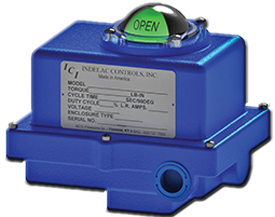
Based on the power source used, actuators can be divided into two main categories:
- Electric actuators: using either one-phase or three-phase power (depending on the size of the application and the availability in site) to energized a set of gears, operating any type of valve.
- Pneumatic or hydraulic actuators: using either a rack & pinion or a scotch yoke device for moving a rotary valve.
They are other types of valve and damper actuators that use a combination of existing motors and gears, but most applications are included into those two categories.
PNEUMATIC AND HYDRAULIC ACTUATORS IN A NUT SHELL
These actuators have a relatively simple mechanism. Small to medium size devices are built with a rack and pinion mechanism and larger devices use a scotch yoke. There are so many rack and pinion actuators manufacturers in the world that these actuators are actually considered more like a commodity product rather than an engineered product. There are considerably less manufacturers of actuators using scotch yoke mechanism but the core mechanical design is close to identical, though some variations do exist.On smaller pneumatic actuators, some standardization of the controls and position feedback exists with international standards like NAMUR. But generally, most pneumatic actuators have added control components like solenoids, position transmitters… manufactured by third party manufacturers.







